Security Alert: Scam Text Messages
We’re aware that some nabtrade clients have received text messages claiming to be from [nabtrade securities], asking them to click a link to remove restrictions on their nabtrade account. Please be aware this is likely a scam. Do not click on any links in these messages. nabtrade will never ask you to click on a link via a text message to verify or unlock your account.
6 Stocks to harness the AI megatrend beyond NVIDIA
Andrew Chambers | Martin Currie
AI is captivating investors worldwide with much promise of change and innovation, but how can income investors benefit from this boom?
With AI growth exploding, listed Real Assets can provide steady income while benefitting from these substantial tailwinds. Critically, Real Asset investments such as Data Centres and Energy Utilities, are essential to AI’s growth.
Being active and owning the right kind of listed Real Assets matters. We believe a blend of select Property, Infrastructure and Utilities can truly benefit from the megatrends of explosive data growth and electricity demand.
Data Centres – The backbone of the AI explosion
Data Centres are the backbone of the AI data explosion, housing servers and storage systems crucial for AI workloads and support cloud computing services. Clients of Data Centres include Hyperscalers such as Amazon Web Services, Microsoft Azure, and Google Cloud Platform.
The global Data Centre market is experiencing rapid growth, driven by the increasing demand for these data services. The Hyperscalers have also set plans to more than double their capital expenditure (capex) from already very high levels just five years ago.
Hyperscaler capex spend (US$ billions)
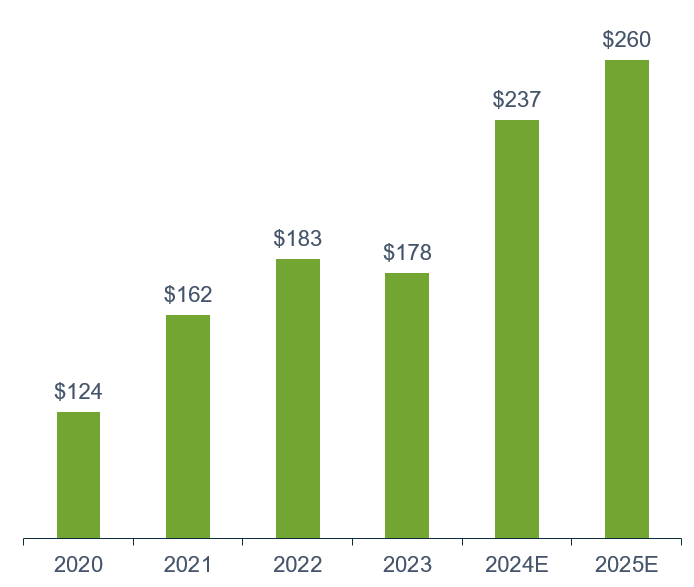
Source: Company Reports & Factset Consensus Estimates, Hyperscalers (Amazon, Microsoft, Google, Meta (Facebook), Apple, Alibaba, Oracle, Tencent, HP, IBM, Baidu, SAP, Salesforce); latest available as of 19 June 2024
As technology advances, AI applications will generate massive amounts of data requiring more sophisticated, robust storage capacity and solutions. Importantly, Data Centre landlords typically charge customers based on their data use, measured in kilowatts rather than the actual space used. This contrasts with say office landlords where rent is charged on a square metre basis.
In Data Centres, this is analogous to charging tenants based on how many people sit on each floor (density) rather than the floor area itself – and AI is driving up density in a huge way. AI deployments ‘occupy’ up to five times more ‘space’ than current uses, as shown by Equinix’s rack densities in the chart below.
Data information created, captured, copied and consumed
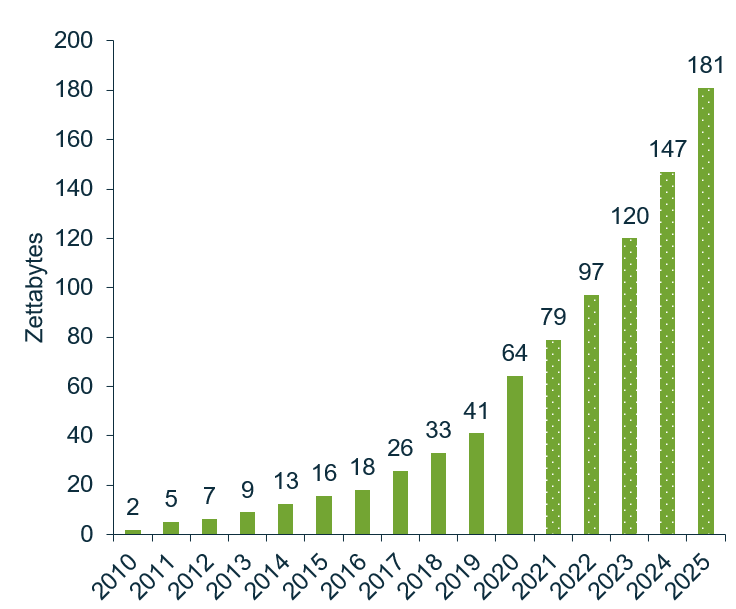
DC & Statista, Volume of data/information created, captured, copied, and consumed worldwide from 2010 to 2020, with forecasts from 2021 to 2025 (in zettabytes) and Source: Redgate, IDC & Statista, Redgate & IDC, Total installed based of data storage capacity in the global datasphere from 2020 to 2025 (in zettabytes) (last visited June 12, 2024)
Equinix: Rack density by type (kw/rack)
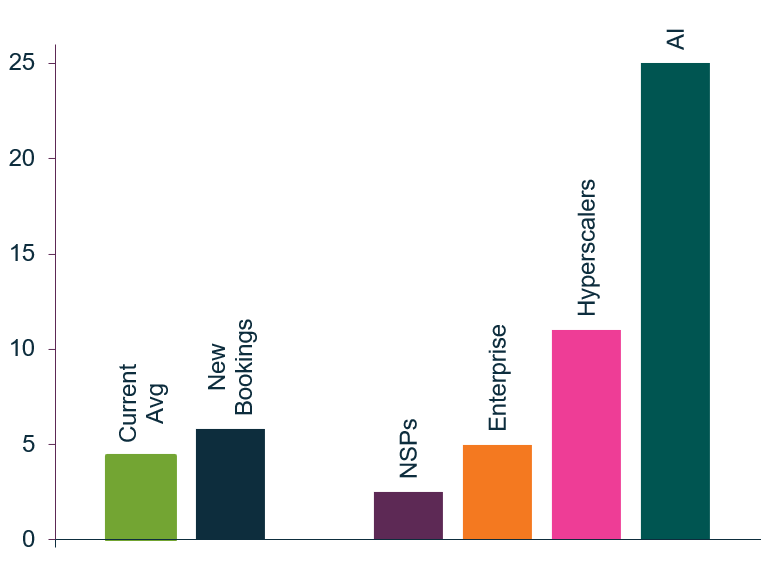
Source: MCA, Equinix; as of 15 May 2024.
For our income-focused portfolio, we prefer listed Real Assets that protect income streams against inflation and provide dollar income growth that meets our “essential ingredients” requirements.

Key Data Centre Investments:
We have identified several listed Data Centres that align with our “essential ingredients” criteria:
- Digital Realty Trust (NYSE: DLR): A global leader in Data Centre ownership and operation, Digital Realty Trust benefits from the tailwinds of rising data usage. With 300+ data centres in over 50 cities, they exhibit healthy rental growth and a strong brownfield development pipeline. Their 15-year dividend growth track record highlights effective management despite the capital-intensive nature of the business. High returns on incremental capital reflect their meaningful value add, as tenants seek out their security of service, global reach and ability to deliver timely products.
- Digital Core REIT (Singapore): Sponsored by Digital Realty, this REIT owns a well-managed Data Centre portfolio with global assets, focusing on the growing hyperscale business. Rising interconnection fees on non-hyperscale assets boost organic growth.
In the face of this very strong tenant demand, and despite large increases in supply, these incumbent Data Centre landlords are enjoying very strong pricing power through their ability to raise rent.
The chart below highlights the uptick in leasing activity for Digital Realty Trust(4) .
Digital Reality: Base rent per kilowatt for Hyperscalers
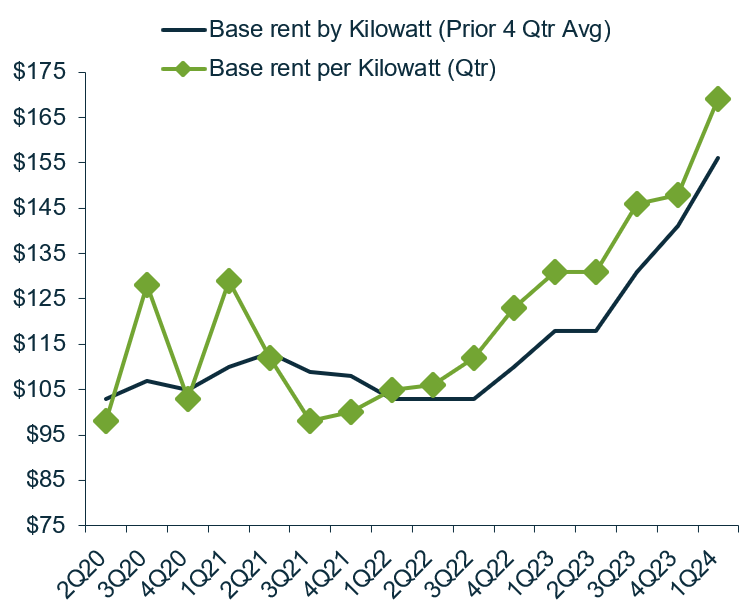
Source: MCA, Digital Realty, FactSet; latest available as of 30 April 2024.
However, not all listed Real Assets with Data Centre exposures meet our essential ingredients criteria. For example, Australia's Goodman Group (ASX: GMG), known for its logistics assets, is also entering the Data Centre market. Its focus on new ‘greenfield’ projects reinforces high development spend and lower dividends.
Coupled with a high multiple, our preference continues to be for the incumbent Data Centre landlords who stand to benefit by billing out their current portfolios and brownfield developments at higher rents.
Energy Utilities – Powering the AI surge sustainably
AI operations, particularly deep learning, require significant computational power. Data Centres must ensure continuous, reliable power supply to prevent downtime and data loss. The International Energy Agency (IEA) reported that an AI query uses around 10 times as much energy (2.9 Wh of electricity per request) as a traditional Google query (0.3 Wh)(5), translating to high electricity consumption by the Data Centres. The IEA report also suggests that global Data Centre electricity demand is set to double by 2026(6), equivalent to Japan’s entire electricity consumption.
As the energy demand grows, the focus shifts towards renewable and sustainable power solutions to reduce carbon footprints and meet regulatory requirements. A shortage of available power and transmission connections could limit Data Centre growth, an issue already observed in some markets. A synergy between AI, Data Centres, and Energy Utilities is crucial, especially as the world shifts towards greener energy sources and upgrades to the transmission grid are required.
IEA: Global electricity demand expectation
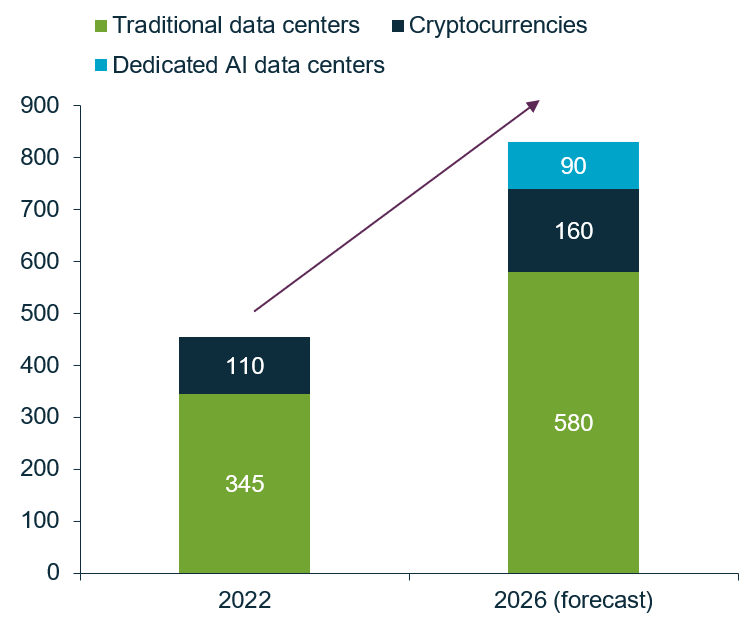
Source: IEA; Electricity 2024 Analysis and forecast to 2026 (January 2024)
Key Energy Utility Investments:
We have identified several utility companies that are supporting the growing AI market and are also expanding their renewable energy portfolios:
- Southern Co (NYSE: SO), Duke Energy (NYSE: DUK) and Dominion Energy (NYSE: D): These U.S. Sunbelt-based integrated Energy Utilities are investing in network upgrades and renewable energy projects to ensure consistent power supply. Data Centre demand growth already drives their demand growth, with Southern Co. reporting a 12% increase in electricity sales in the first quarter of 2024, compared with the same period last year(7).
- AGL Energy (ASX: AGL): A leading integrated energy company, AGL is focusing on battery storage and renewable energy to support the growing Data Centre market. Significant expansion plans in Australia’s Data Centre sector announced over the last 12 months are expected to drive energy demand growth in the years ahead (8).
- National Grid (UK): This British multinational operates UK energy transmission networks predominately in electricity. In mid-2024, the company announced a significant step up in energy infrastructure investment worth around £60 billion over the next five years¸ supporting the energy transition and growth in Data Centres, AI and electrification(9).
Martin Currie’s listed Real Asset strategies align with the AI boom
Investing in AI-related opportunities extends beyond the expensive, dividend-less tech giants like NVIDIA (NASDAQ: NVDA) and the ‘magnificent seven’. Savvy investors, especially those seeking reliable income, should consider the critical infrastructure supporting the AI ecosystem as Data Centres and Energy Utilities.
Through active management, the Martin Currie Australia Real Income and Global Real Income strategies can provide an effective exposure to these sectors:
- Avoiding Concentrated US Bias: Passive Real Asset investing, particularly through ETFs, often focuses on indices with a concentrated US bias, neglecting opportunities in other regions crucial for AI development.
- Transparency and Liquidity: Focusing on listed investments provides access to Data Centres and Energy Utilities sub-sectors not well-represented in the unlisted market, avoiding many transparency and liquidity issues.
- Balanced Approach: Investing in Data Centres and Energy Utilities alongside a blend of best-in-class listed Infrastructure/Utilities securities, offers a balanced approach, combining growth potential with stable income generation.
- Diversified Exposure: A broader opportunity set limits individual security, sector, and industry concentration risk,
enabling strategic moves between the sectors when better opportunities arise to increase income and total returns.
- Managing Valuation Risks: This diversified exposure also helps manage the valuation risks seen in other segments of the AI ecosystem.
Ultimately, we believe that our unique listed Real Asset strategies will help investors align with the AI boom and offer a stable income stream, making them an attractive option for income-focused portfolios.
Learn how the industry leaders are navigating today's market every morning at 6am. Access Livewire Markets Today.
6 Source: IEA; Electricity 2024 Analysis and forecast to 2026 (January 2024)
7 Source: Southern Company; First Quarter 2024 Earnings Conference Call presentation (May 2024)
8 Source: Statista Inc.; Data Center - Australia (last visited June 12, 2024)
9 Source: National Grid; Investing for growth (May 2024)
All prices and analysis at 28 June 2024. This document was originally published in Livewire Markets on 28 June 2024. This information has been prepared by MARTIN CURRIE INVESTMENT MANAGEMENT LIMITED, operating within Franklin Templeton Australia Limited (ABN 76 004 835 849, AFSL 240827).
The content is distributed by WealthHub Securities Limited (WSL) (ABN 83 089 718 249)(AFSL No. 230704). WSL is a Market Participant under the ASIC Market Integrity Rules and a wholly owned subsidiary of National Australia Bank Limited (ABN 12 004 044 937)(AFSL No. 230686) (NAB). NAB doesn’t guarantee its subsidiaries’ obligations or performance, or the products or services its subsidiaries offer. This material is intended to provide general advice only. It has been prepared without having regard to or taking into account any particular investor’s objectives, financial situation and/or needs. All investors should therefore consider the appropriateness of the advice, in light of their own objectives, financial situation and/or needs, before acting on the advice. Past performance is not a reliable indicator of future performance. Any comments, suggestions or views presented do not reflect the views of WSL and/or NAB. Subject to any terms implied by law and which cannot be excluded, neither WSL nor NAB shall be liable for any errors, omissions, defects or misrepresentations in the information or general advice including any third party sourced data (including by reasons of negligence, negligent misstatement or otherwise) or for any loss or damage (whether direct or indirect) suffered by persons who use or rely on the general advice or information. If any law prohibits the exclusion of such liability, WSL and NAB limit its liability to the re-supply of the information, provided that such limitation is permitted by law and is fair and reasonable. For more information, please click here.
